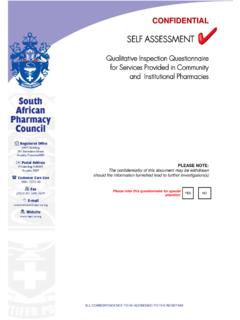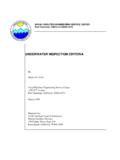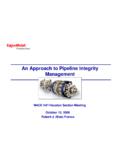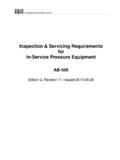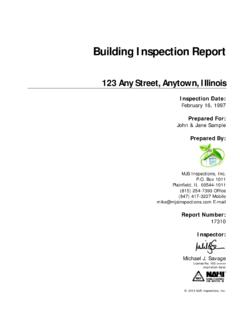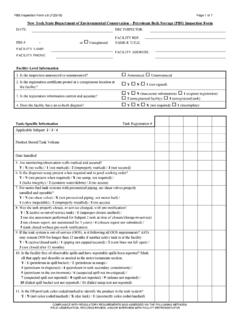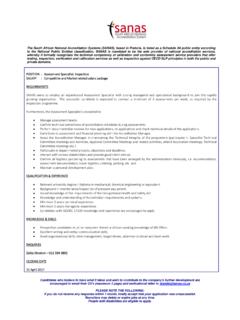Transcription of Technical policy on safety case assessment relating …
1 HEALTH AND safety EXECUTIVE HAZARDOUS INSTALLATIONS DIRECTORATE OFFSHORE DIVISION Technical policy On safety case assessment relating to structural integrity Providing an Outline of Information Expected to be provided In safety Cases Contact: M Birkinshaw OSD Priestley House, Priestley Road, Basingstoke RG24 9NW Tel 01256 404161 Purpose of Issue Rev Date of Issue Technical Author policy Contributions Technical Editor Issued for Comment 0 June 2009 V (Karthi) Karthigeyan M Birkinshaw V (Karthi) Karthigeyan Comment 1 June 2009 M Birkinshaw V (Karthi) Karthigeyan Issued 2 November 2009 V (Karthi) Karthigeyan & M Birkinshaw M Birkinshaw V (Karthi)
2 Karthigeyan Technical policy ON safety case assessment relating to structural integrity Technical policy The Offshore Installations ( safety case Regulations) 2005 require duty holders to include in the safety case sufficient particulars to demonstrate that (a) their management system is adequate to ensure that the relevant statutory provisions (HSW Act, PFEER & DCR) are complied with. It also requires the arrangements with contractors to ensure compliance (Regulation 12). (b) there are adequate arrangements for audits including reporting (Regulation 12). (c) all hazards with the potential to cause a major accident have been identified (Regulation 12); and (d) all major accident risks have been evaluated and measures have been, or will be, taken to control those risks to ensure compliance with the relevant regulations (Regulation 12).
3 (e) specific information required by the Schedules to the regulations to be included in the case Impact of this policy This policy document provides information to specialist structural inspectors as to what duty holders can be expected to provide in their safety cases and design notifications. It enables consistency in applying the safety case regulations and is based on good practice obtained from safety case submissions to date. Nature of Threat The purpose of the structure is to provide adequate support for all the equipment, accommodation and temporary refuge on the offshore installation.
4 Failure or even partial failure of the structure can lead directly or indirectly to inadequate support, leading to casualties. Hence the need to include adequate particulars relating to structural aspects of hazards, risks and related management arrangements in the safety case to enable specialist structural inspectors to assess their adequacy. Risk Level Sound engineering principles should be used to keep the risk of loss of integrity to a low level. Managing the risk by use of techniques and methods in the ISO Standards for offshore Structures (or equivalent) is used to ensure that no sudden, catastrophic failure is encountered.
5 The use of quantified risk assessment (QRA or other) could be used as a substitute for using sound engineering principles or complying with suitable codes and standards but the limitations and uncertainties of such techniques should be taken into account. Requirements of the safety case Regulations Regulation 12 requires sufficient particulars to demonstrate . This is expanded in this document to include in addition to identification of all hazards, evaluation of risks, and sufficient details of the process; of identification of a range of potential measures for further risk reduction; systematic analysis of each of these measures to evaluate safety and associated benefits; evaluation of compliance with the relevant statutory provisions (usually reasonable practicability) of the identified measures including implementation; and a record of the process and results.
6 To satisfy the requirement: measures have been, or will be, taken to control those risks . structural engineers normally limit risks by ensuring that the structure is adequate to satisfy certain codes or standards. This document provides additional guidance to interpret the above requirements, in relation to structural integrity . Pyramid Structure Complete documentation of risk evaluation and other tasks listed above cannot practically be part of the safety case . The submission should contain a summary with the results and the detailed documentation should be referenced. Hence The safety case should be considered as the top document of a pyramid, supported by other documents containing more details.
7 SafetyCaseAdditionalInformationRisk AssessmentDetailed Engineering safety case Triangle Fig 1 Minimum information that can be expected in the safety case is given in Appendix A against each part of the regulation. Additional details relating to the Schedules are contained in Appendix B. Depending on the hazard; the duty holder will be expected to provide sufficient details to satisfy the regulations. The following paragraphs provide additional information in support. Codes and standards The codes and standards used should be listed in the safety case . The ISO standards listed below and other codes and standards do provide a measure of good practice, equating to a qualitative measure of an acceptable probability against failure due to applied loads.
8 Complying with them or other suitable codes or standards is essential but may not be entirely adequate for controlling risks and complying with these regulations in all cases (eg. accidental events). Paragraphs on performance standards, safety critical elements, limit of safe operation and risk assessment provide additional information necessary to ensure compliance. Standards General Requirements for Offshore Structures ISO 19900 Metocean Requirements ISO 19901 -1 Seismic Requirements ISO 19901 - 2 Topsides Requirements ISO 19901 - 3 Foundation Requirements ISO 19901 - 4 Weight Engineering ISO 19901 - 5 Marine Operations ISO 19901 - 6 Stationkeeping ISO 19901 - 7 Marine Soil Investigation ISO 19901 - 8 Fixed Steel Structures ISO 19902 Fixed Concrete Structures ISO 19903 Floating MSS ISO 19904 - 1 MOUs - Jackups 19905 - 1 safety critical elements The global failure of the structure is likely to result in a large number of
9 Casualties and some safety cases refer to the structure as a whole as a safety critical element. This may be adequate practice in the absence of detailed performance standards for each subgroup of members or sub-structures. However it does not recognize the fact that there are circumstances where a failure or partial failure of a secondary or even tertiary structural member could: cause or contribute substantially to a major accident, if, say, they carry equipment containing hydrocarbons; or fail to prevent or limit the effects of a major accident, if they carry EER or other emergency systems.
10 The safety critical structural elements should be identified by: event tree analysis with failure or partial failure of the structural member, sub-structure or structure and fault tree analysis that points to failure or partial failure of a structural member, sub-structure or structure. Other means may be used to ensure that the consequences of failure or partial failure of structural members or substructures on equipment, EER and emergency systems are taken account of. Performance Standards and Limits of safe Operation In nearly all cases or situations, complying with codes and standards are essential but other measures are also required to satisfy all necessary performance standards.










